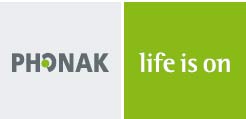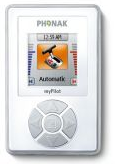Interview with Nathan Schau, Au.D., Manager of Audiology, Phonak US
Topic: Phonak Zoom Technology

Nathan Schau, Au.D.
SMAKA: This is Carolyn Smaka from AudiologyOnline, and I'm speaking with Dr. Nathan Schau from Phonak. Nathan, thanks for coming on AudiologyOnline today.
SCHAU: Thanks for having me.
SMAKA: It's a pleasure. Before we get into our topic today, Phonak's Zoom technology, can you tell me about your role at Phonak and your background?

SCHAU: I'm the Manager of Audiology for Phonak U.S. My primary role entails managing clinical trials and developing evidence-based research for new hearing solutions. I also represent Phonak at different industry functions and write articles for hearing health care journals.
I'm an audiologist, and I dispensed hearing aids during my clinical career. Prior to becoming Manager of Audiology, I held other roles at Phonak including being an outside trainer, as well as in technical support.
SMAKA: Thanks Nate. I'm looking forward to getting into the Zoom technology. There are three different Zoom features, correct?
SCHAU: Correct. There are three primary Zooms that we're focusing on in our Spice generation of products: StereoZoom, auto ZoomControl, and UltraZoom with SNR boost. Phonak's Zoom features were designed to help improve signal to noise ratio and help in those situations when the listener isn't able to look at the speaker.
We can talk first about StereoZoom feature. StereoZoom is available as a manual program in the premium-level Spice platform (S) hearing aids that have directional microphones. These products include the Ambra, all of the Audéo S IX wireless configurations, and the Naída S IX. The Ambra line does include custom models and standard BTEs, while the Audéo is a receiver-in-the-ear line and the Naída is a BTE.
With StereoZoom, both hearing instruments switch into a focused directional mode and simultaneously the full audio signal is shared between aids. This allows a person to hear and focus on someone in front of them. This is a great manual solution when in the most challenging of environments like a party or a noisy restaurant. The wearer can press a button on the hearing aid and change into this dedicated program during those situations.
SMAKA: You mentioned that part of your role at Phonak is performing clinical trials. If people wanted to read up on the data behind StereoZoom, where would you direct them?
SCHAU: There are field studies available from Phonak that can be obtained by calling us directly or by contacting your sales representative for the data. For those interested in learning about these features in greater depth, I invite them to go to my online course entitled- Zoom Technology: How do you Zoom?
SMAKA: Is auto ZoomControl related to the original ZoomControl that was released a few years back?
SCHAU: Yes, the auto ZoomControl feature is an evolution of our original ZoomControl. That allows the wearer to focus on a direction other than the front.
SMAKA: That is obviously a different concept that the straight-forward directional microphone approach. Can you explain how that works?
SCHAU: Well, it depends on how the user wants to zoom. The hearing aids provide wearers a range of zoom capabilities, depending on their specific needs. They can actually focus in, directionally, on a speaker without even having to look at them. The best example of this is in the car you have a passenger next to you or if there are people sitting in the back seat that you want to focus on.
Imagine driving in the car with the radio on, and wanting to listen to passengers both next to you and in the back seat. The user switches in to autoZoom Control which is a manual program where the hearing aids focus on the loudest speech signal, regardless of the direction. Without this benefit, you can only focus to the front, and in a driving situation, all you hear is the air conditioning, heat or radio! The ability to focus on different directions has been an outstanding benefit for literally tens of thousands of wearers. If readers are interested in understanding more of the technology behind the feature, please check the online course or the field studies.

Illustration of Zoom technology
Zoom to the front and back are fairly straight forward, Zoom to the right and left are a little more complicated
If the user zooms to the right, the right hearing instrument will stay in an omni-directional mode and the microphone on the left aid will be attenuated by 20 dB. The audio signal coming into the right hearing aid will wirelessly stream to the left hearing instrument so that everything that comes in to the right ear will be heard in the left ear. If you were zooming to the left, the process would be the exact opposite.
SMAKA: And how do patients access that manual program?
SCHAU: They are able to access this through a remote control, or they can access it through the push-button on the hearing instruments as well.
SMAKA: You mentioned remote control. What is available in your current remote line-up?
SCHAU: We have the MyPilot and also the new PilotOne, which was introduced with this generation of products.

Phonak MyPilot remote control for use with preveious generation Core platform instruments as well as Spice generation instruments.

Phonak PilotOne remote control released with the new Spice platform and associated instruments.
SMAKA: There's so much flexibility within the fitting that it sounds like it could be customized for whatever that person's needs are. A good needs assessment would be required to get the maximum benefit, right?
SCHAU: Absolutely. I would recommend using an open ended needs assessment like the COSI to get an idea of which situations the patient wants to hear better in. We know that in most cases noisy restaurants and the car are two of the most difficult situations for hearing aid users which are what StereoZoom and autoZoomControl are designed for.
SMAKA: UltraZoom with SNR (signal-to-noise ratio) boost is the most advanced type of zoom, correct?
SCHAU: I'd say that StereoZoom is the most advanced in terms of a feature that uses wireless streaming of the audio signal and UltraZoom with SNR boost is the most advanced directional feature that doesn't require wireless streaming. Yes, the UltraZoom with SNR boost is really the next generation of directional microphones. As you know Phonak has pioneered directionality for a long time. UltraZoom is a multichannel adaptive directional system, which means that directionality changes within each channel based on the loudest noise source in that channel.
The SNR boost is what we call a "spatial noise canceller." This means that when the hearing instruments are in the UltraZoom mode, they will analyze the signal to noise ratio in both the front and back planes. Then, the system will look for where there is a poor signal-to-noise ratio and it will apply another level of noise canceling on top of the standard noise canceling that is only active when the aids are in the directional mode. This goes beyond what we are already doing with multichannel adaptive directionality in terms of improving signal to noise ratio. Essentially, this minimizes noise for the client when they're in a very noisy environment. UltraZoom is part of the universal automatic program, SoundFlow.
SMAKA: When you say "multichannel adaptive directionality," how many channels is that?
SCHAU: Premium products, Ambra and the IX-level products, have 33 channels. In the advanced products, which include the Solana and V-level products, there are 12 channels. In the Cassia and III-level hearing aids there is one channel of beam-forming.
SMAKA: What tips does Phonak provide to making a product selection and deciding the directional fitting strategy?
SCHAU: A lot of it comes down to how regularly the client is in background noise and how loud that background noise is. We would recommend using an open ended needs assessment such as the COSI and we also provide fitters with a product selection guide to help them determine which technology fits their patient's needs. This can be obtained from their sales rep.
SMAKA: When you fit premium hearing instruments with Zoom technology, how do you know when the client may need further assistance, say for example an FM system?
SCHAU: Directional microphones can benefit clients with all degrees of hearing loss and SNR loss. Typically, FM is used for more severe hearing losses and greater SNR losses. If you routinely in your clinical protocol run a QuickSIN test and you notice a client who has a fairly poor SNR, they may be a client who may need FM either now or down the road. Generally, we recommend fitting FM after the client has had the opportunity to use optimally fit hearing aids in different situations. If you feel the fitting is the best it can be and the client is having issues where noise or distance are factors and an FM system will match with their lifestyle, it may warrant an FM recommendation.
SMAKA: With the Zoom technology you've discussed, how can it be verified? Is this something that you verify in the text box, on the patient, through a listening check, or how can you otherwise tell that it's working as intended?
SCHAU: Typically in terms of verification, you can verify the directional microphones themselves using a test box or on-ear measure. The same can be said for Zoom Front and Zoom Back. With StereoZoom it's tougher to verify because you'll need a more diffuse listening situation to see the effect. With ZoomControl to the Right and Left there isn't at this time a protocol that is recommended for verification. Listening checks are always good practice. With auto ZoomControl, listening with one aid while talking into the other aid or rubbing your finger over the microphone can give you a sense of what is happening. With StereoZoom, you can also do a listening check.
SMAKA: Thanks for your time today, Nathan in covering Zoom technology from candidacy, to fitting and verification. I learned a lot!
SCHAU: Thanks, Carolyn. You have a great afternoon.
SMAKA: You, too.
For more information about Phonak, visit www.Phonak.com or the Phonak web channel on AudiologyOnline.


